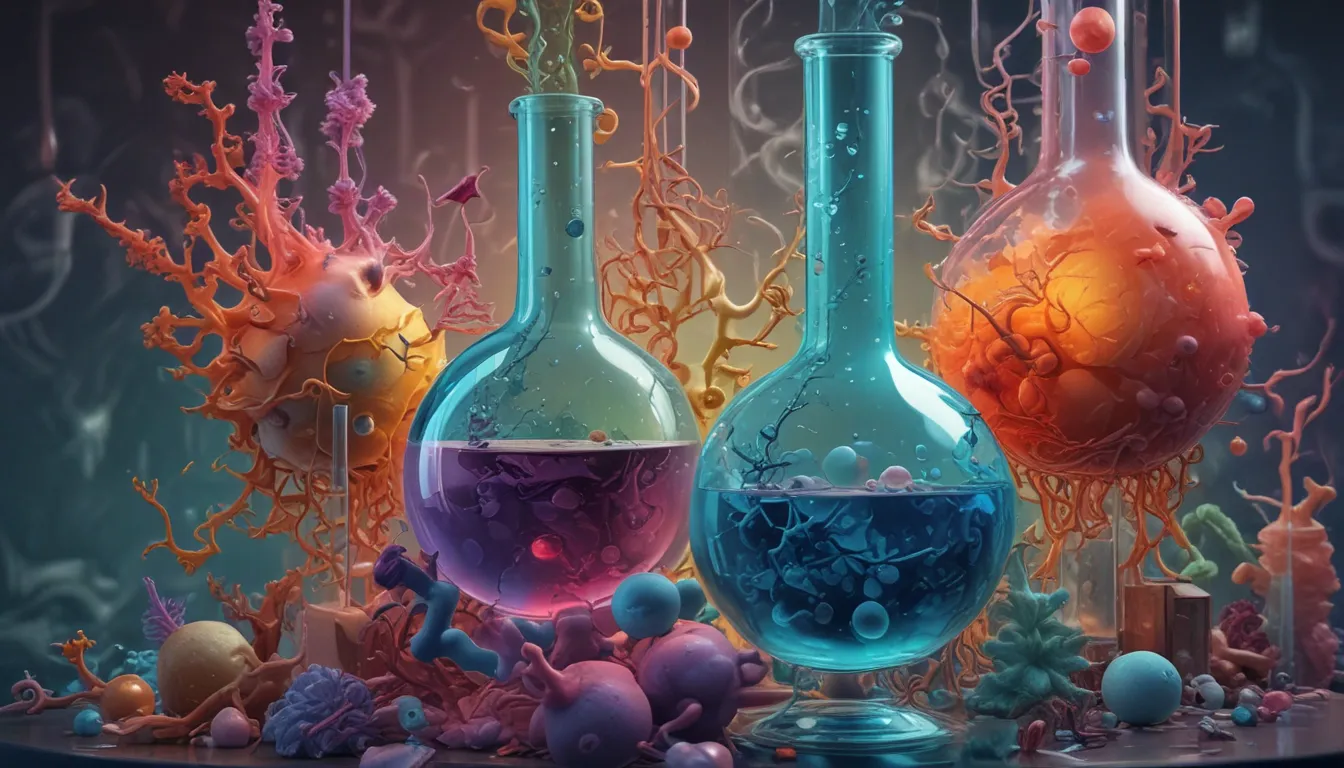A Note About Images: The images used in our articles are for illustration purposes only and may not exactly match the content. They are meant to engage readers, but the text should be relied upon for accurate information.
Biophysical chemistry, a captivating field that amalgamates biology and physical chemistry, delves into the intricate physical principles and techniques governing biological systems. By unraveling the molecular mechanisms behind essential biological processes, biophysical chemistry shines a light on how living organisms operate at the molecular level, all while adhering to the laws of physics.
Unveiling the Marvels of Biophysical Chemistry
Biophysical chemistry serves as a cornerstone in various scientific domains, including biochemistry, molecular biology, and pharmacology, offering valuable insights into the structure and dynamics of biological macromolecules. This article aims to explore 13 surprising facts about biophysical chemistry, ranging from cutting-edge techniques to pivotal discoveries that underscore the role of this discipline in enhancing our comprehension of life itself.
Key Takeaways:
- Biophysical chemistry merges biology and physical chemistry to scrutinize living organisms at the microscopic level, shedding light on DNA, proteins, and energy processes essential for drug development and sustainable energy solutions.
- Employing innovative tools, such as X-ray crystallography, nuclear magnetic resonance spectroscopy, and mass spectrometry, biophysical chemistry pioneers cellular investigations, protein folding studies, and membrane dynamics, while propelling advancements in nanotechnology and biomedical engineering.
Introducing the Intersection of Biology and Physical Chemistry
At the heart of biophysical chemistry lies the fusion of biology and physical chemistry. This interdisciplinary field focuses on unraveling the chemical processes within living organisms, deciphering the molecular mechanisms governing biological processes, and leveraging physical techniques to scrutinize and manipulate biological systems.
Decoding Biomolecular Structures and Functions
Central to biophysical chemistry is the examination of biomolecules like proteins, nucleic acids, and lipids. Through sophisticated tools and methods, researchers can delve into the interactions, dynamics, folding, and stability of these molecules, providing crucial insights into their roles within cellular processes.
Harnessing High-Tech Tools in Biophysical Research
Biophysical chemists harness an array of advanced techniques and instruments to explore biological systems at the molecular level. From fluorescence spectroscopy to electron microscopy, these tools enable in-depth studies of protein folding, membrane biophysics, and cellular processes, shaping the landscape of biophysical investigations.
Unraveling the Energetics of Biological Systems
Biophysical chemistry delves into the utilization and transmission of energy within biological systems, probing enzyme catalysis, energy conversion in photosynthesis, and the intricate relationship between energy and molecular structures. This exploration aids in understanding fundamental biological processes essential for life.
Driving Drug Discovery and Development
The pivotal role of biophysical chemistry extends to drug discovery and development, where it guides the identification of therapeutic targets, characterizes drug-target interactions, and refines drug candidates for enhanced efficacy and safety. This synergy between biophysical chemistry and pharmacology paves the way for innovative therapies.
Illuminating the Depths of Cellular Signaling
A cornerstone of biophysical chemistry is the investigation of cellular signaling processes, elucidating the molecular interactions that regulate cellular responses. By unraveling these signaling pathways, researchers gain insights into how cells communicate and orchestrate intricate biological processes.
Unveiling the Mechanics of DNA Replication
Biophysical chemistry has significantly contributed to our understanding of DNA replication, a fundamental process in all living organisms. From unveiling the mechanisms of DNA unwinding to deciphering replication fork progression, this field sheds light on the fidelity of DNA synthesis critical for life’s continuity.
Probing Protein Folding and Misfolding
Protein folding, a pivotal process in biophysical chemistry, explores how linear polypeptide chains acquire their three-dimensional structures. Delving deeper, researchers investigate protein misfolding, linked to neurodegenerative diseases like Alzheimer’s and Parkinson’s, offering insights into potential therapeutic interventions.
Investigating Membrane Dynamics and Transport
Membrane biophysics, a specialized branch of biophysical chemistry, delves into the study of biological membranes. By scrutinizing membrane structure, dynamics, and transport processes, researchers unveil the mechanisms vital for cell integrity and functionality, shaping our understanding of cellular dynamics.
Nurturing Computational Models for Biological Simulations
Biophysical chemists leverage computational models to simulate and predict biological phenomena, aiding in the understanding of intricate processes like protein-ligand interactions, molecular dynamics, and drug binding affinities. These models serve as invaluable tools in deciphering complex biological systems.
Pioneering Biomedical Engineering Applications
The realm of biophysical chemistry extends to biomedical engineering, where it fuels the design and development of medical devices, biomaterials, and tissue engineering constructs. By optimizing the compatibility and performance of these technologies, biophysical chemistry drives innovations in healthcare and medical sciences.
Shaping the Future Through Nanotechnological Advancements
Biophysical chemistry plays a pivotal role in shaping the ever-evolving field of nanotechnology. By enabling the design and fabrication of nanoscale materials, devices, and sensors for diverse applications, ranging from healthcare to renewable energy, this discipline propels advancements in nanoscience and technology.
Spearheading Sustainable Energy Solutions
In the quest for sustainable energy solutions, biophysical chemistry emerges as a key player. By elucidating the conversion of sunlight into chemical energy in natural photosynthetic systems and paving the way for artificial photosynthesis, this field lays the groundwork for renewable energy production, fostering a greener future.
Conclusion: Navigating the Frontiers of Biophysical Chemistry
As we conclude our exploration of the captivating realm of biophysical chemistry, we unravel the intricate web of biological processes, molecular interactions, and physical forces that shape life itself. From deciphering the complexities of protein folding to driving advancements in drug discovery and nanotechnology, biophysical chemistry stands at the forefront of scientific discovery, bridging disciplines and unveiling the mysteries of the natural world.
FAQs – Unlocking the Secrets of Biophysical Chemistry
-
What is biophysical chemistry?
Biophysical chemistry is a scientific discipline that integrates principles from biology and physical chemistry to study the physical and chemical properties of biological systems at the molecular level. -
What are some applications of biophysical chemistry?
Biophysical chemistry finds applications in understanding protein folding, enzyme kinetics, drug design, and the development of biomaterials for biomedical applications. -
How does biophysical chemistry contribute to drug discovery?
Biophysical chemistry aids in comprehending drug-target interactions, facilitating the design of more effective and targeted therapies for various diseases. -
Is biophysical chemistry an interdisciplinary field?
Yes, biophysical chemistry is highly interdisciplinary, drawing insights from biology, chemistry, physics, and computational modeling to address complex biological questions. -
How does biophysical chemistry enhance our understanding of biological processes?
Biophysical chemistry offers a quantitative understanding of the physical forces governing biochemical reactions and biological processes, unveiling the mechanisms driving life’s intricacies. -
What techniques are commonly used in biophysical chemistry?
Spectroscopy, X-ray crystallography, mass spectrometry, nuclear magnetic resonance (NMR) spectroscopy, and computational modeling are among the prevalent techniques employed in biophysical chemistry research. -
How does biophysical chemistry contribute to nanotechnology?
Biophysical chemistry provides insights into biomolecular behavior at the nanoscale, enabling the design of novel nanomaterials and devices with diverse applications in healthcare and renewable energy. -
Can biophysical chemistry aid in understanding diseases?
Yes, biophysical chemistry plays a pivotal role in unraveling the molecular basis of diseases, such as protein misfolding in neurodegenerative disorders, facilitating the development of targeted therapies. -
What are the career prospects in biophysical chemistry?
Numerous career opportunities exist in biophysical chemistry, spanning research positions in academia, industry, and governmental laboratories, as well as roles in teaching and consulting. -
How can one engage in biophysical chemistry research?
To embark on biophysical chemistry research, individuals can pursue degrees in chemistry, biochemistry, or biophysics and seek research opportunities with institutions and professors conducting research in this captivating field.
Engage With Trustworthy Content
Our unwavering commitment to delivering reliable and engaging content forms the cornerstone of our endeavors. Each fact shared on our platform is a testament to the contributions of real users like you, enriching our collective pool of knowledge. With a steadfast dedication to accuracy and authenticity, our editors meticulously curate each submission to offer you insights that are not only captivating but also credible. Trust in our unwavering dedication to quality as you embark on a journey of exploration and learning with us.






